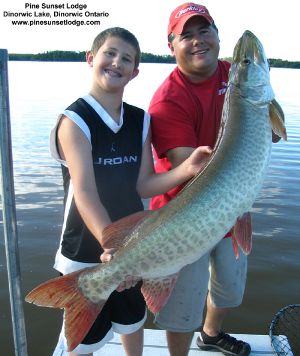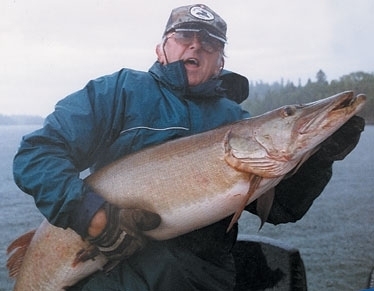
Staying Ahead of the Jones
Muskellunges are very well adapted to be
the dominate predators that they are. First, Muskellunges have
evolved to the color of their environment; they are usually a green
or silver in color. Both of these colors serve well as camouflage
from predators when young, and while waiting for prey as adults (if
they feel so patient).
![]()
![]() However, Muskellunges are usually go getters
when it comes to pursuing food. For this, Muskellunges have other
adaptations that give them the ability to dominant their
niches. Despite their immense size, Muskellunges are very
quick. They have a streamline body and a sharply
pointed head,
allowing for minimum water resistance. Also, their strong jaws allow
for capturing and chewing of prey. These jaws can lock into position
and wait for the prey to die in the Muskellunge's mouth. If you ever
look at a Muskellunge, you may notice another adaptation: teeth! Not
only do they have a lot of teeth, but they are also all very sharp.
Also, Muskellunges instinctively grab for prey by their head region.
It is very rare to see a Muskellunge approach a potential meal from
behind. The final key aspect of Muskellunge's physical
characteristic that allow them to be such successful predators is
their eyesight. For this reason, Muskellunges are rarely caught in
murky lakes--because their keenly developed eyesight is negated by
the dirty water.
However, Muskellunges are usually go getters
when it comes to pursuing food. For this, Muskellunges have other
adaptations that give them the ability to dominant their
niches. Despite their immense size, Muskellunges are very
quick. They have a streamline body and a sharply
pointed head,
allowing for minimum water resistance. Also, their strong jaws allow
for capturing and chewing of prey. These jaws can lock into position
and wait for the prey to die in the Muskellunge's mouth. If you ever
look at a Muskellunge, you may notice another adaptation: teeth! Not
only do they have a lot of teeth, but they are also all very sharp.
Also, Muskellunges instinctively grab for prey by their head region.
It is very rare to see a Muskellunge approach a potential meal from
behind. The final key aspect of Muskellunge's physical
characteristic that allow them to be such successful predators is
their eyesight. For this reason, Muskellunges are rarely caught in
murky lakes--because their keenly developed eyesight is negated by
the dirty water.
Other general fish adaptations seen in the Muskellunge
include a lobed tail and a lateral line system. This series of pores
along the side of the fish allow the musky  to sense water
vibrations. Therefore, they may be able to feel the flopping of an
injured fish and race in for an easy meal. Other distinctive
features of Muskellunges include their: pointed tail, side bars, and
pores on the bottom jaw. The lobed tail allows for greater
directional influence with less flaps. In this sense, Muskellunges
hold an advantage over their relative
Esox lucius, Northern
Pike's tails have rounded lobes. The pointed ends of Muskellunges
act as a sharper ruder in the water. The sensatory pores
to sense water
vibrations. Therefore, they may be able to feel the flopping of an
injured fish and race in for an easy meal. Other distinctive
features of Muskellunges include their: pointed tail, side bars, and
pores on the bottom jaw. The lobed tail allows for greater
directional influence with less flaps. In this sense, Muskellunges
hold an advantage over their relative
Esox lucius, Northern
Pike's tails have rounded lobes. The pointed ends of Muskellunges
act as a sharper ruder in the water. The sensatory pores
 on the
bottom jaw (usually 6 or more on each side of jaw) act as a lateral
line system for the under side of the fish. These pores allow
Muskellunges to approximate prey's distance below them, so that they
can swoop in a dramatic kill.
What
kind of
interactions do Muskellunges experience?
on the
bottom jaw (usually 6 or more on each side of jaw) act as a lateral
line system for the under side of the fish. These pores allow
Muskellunges to approximate prey's distance below them, so that they
can swoop in a dramatic kill.
What
kind of
interactions do Muskellunges experience?